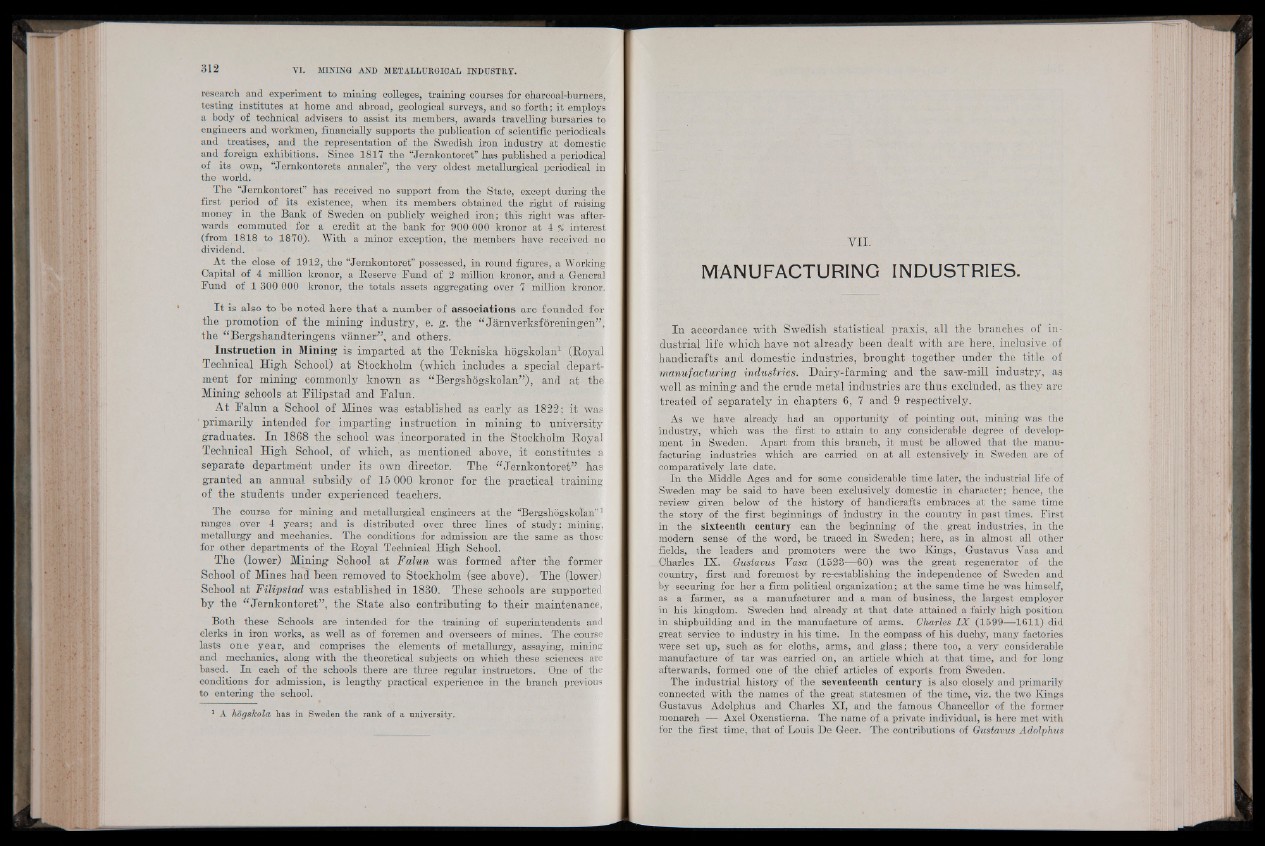
research and experiment to mining colleges, training courses for charcoal-burners,
testing institutes at home and abroad, geological surveys, and so forth; it employs
a body of technical advisers to assist its members, awards travelling bursaries to
engineers and workmen, financially supports the publication of scientific periodicals
and treatises, and the representation of the Swedish iron industry at domestic
and foreign exhibitions. Since 1817 the “Jemkontoret” has published a periodical
of its own, “Jemkontorets annaler”, the very oldest metallurgical periodical in
the world.
The “Jemkontoret” has received no support from the State, except during the
first period of its existence, when its members obtained the right of raising
money in the Bank of Sweden on publicly weighed iron; this right was afterwards
commuted for a credit at the bank for 900 000 kronor at 4 % interest
(from 1818 to 1870). With a minor exception, the members have received no
dividend.
At the close of 1912, the “Jemkontoret” possessed, in round figures, a Working
Capital of 4 million kronor, a Reserve Fund of 2 million kronor, and a General
Fund of 1 300 000 kronor, the totals assets aggregating over 7 million kronor.
It is also to be noted here that a number of associations are founded for
the promotion of the mining industry, e. g. the “Jarnverksforeningen”,
the “Bergshandteringens vanner”, and others.
Instruction in Mining is imparted at the Tekniska hogskolan1 (Royal
Technical High School) at Stockholm (which includes a special department
for mining commonly known as “Bergshogskolan”), and.at the
Mining schools at Bilipstad and Baiun.
At Baiun a School of Mines was established as early as 1822; it was
' primarily intended for imparting instruction in mining to university
graduates. In 1868 the school was incorporated in the Stockholm Royal
Technical High School, of which, as mentioned above, it constitutes a
separate department under its own director. The “ Jemkontoret” has
granted an annual subsidy of 15 000 kronor for the practical training
of the students under experienced teachers.
The course for mining an d . metallurgical engineers at the “Bergshogskolan”1
ranges over 4 years; and is distributed over three lines of study: mining,
metallurgy and mechanics. The conditions for admission are the same as those
for other departments of the Royal Technical High School.
The (lower) Mining School at Falun was formed after the former
School of Mines had been removed to Stockholm (seu above). The (lower)
School at Filipstad was established in 1830. These schools are supported
by the “ Jemkontoret”, the State also contributing to their maintenance,
Both these Schools are intended fo r the training of superintendents and
clerks in iron works, as well as of foremen and overseers of mines. The course
lasts o n e year, and comprises the elements of metallurgy, assaying, mining
and mechanics, along with the theoretical subjects on which these sciences are
based. In each of the schools there are three regular instructors. One of the
conditions for admission, is lengthy practical experience in the branch previous
to entering the school.
1 A hogslcola has in Sweden the rank of a university.
VII.
MANUFACTURING INDUSTRIES.
In accordance with Swedish statistical praxis, all the branches of industrial
life which have not already been dealt with are here, inclusive of
handicrafts and domestic industries, brought together under the title of
manufacturing industries. Dairy-farming and the saw-mill industry, as
well as mining and the crude metal industries are thus excluded, as they are
treated of separately in chapters 6 , 7 and 9 respectively.
As we have already had an opportunity of pointing out, mining was the
industry, which was the first to attain to any considerable degree of development
in Sweden. Apart from this branch, it must be allowed that the manufacturing
industries which are carried on at all extensively in Sweden are of
comparatively late date.
In the Middle Ages and for some considerable time later, the industrial life of
Sweden may be said to have been exclusively domestic in character; hence, the
review given below of 1 the history of handicrafts embraces at the same time
the story of the first beginnings of industry in thé country in past times. First
in thé sixteenth century can the beginning of th e . great industries, in the
modern sense of the word, be traced in Sweden; here, as in almost all other
fields, the leaders and promoters were the two Kings, Gustavus Vasa and
Charles IX. Gustavus Vasa (1523— 60) was the great regenerator of the
country, first and foremost by re-establishing the independence of Sweden and
by securing for her a firm political organization ; at the same time he was himself,
as a farmer, as a manufacturer and a man of business, the largest employer
in his kingdom. Sweden had already at that date attained a fairly high position
in shipbuilding and in the manufacture of arms. Charles IX (1599—1611) did
great service to industry in his time. In the compass of his duchy, many factories
were set up, such as for cloths, arms, and glass; there too, a very considerable
manufacture of tar was carried on, an article which at that time, and for long
afterwards, formed one of the chief articles of exports from Sweden.
The industrial history of the seventeenth century is also closely and primarily
connected with the names of the great statesmen of the time, viz. the two Kings
Gustavus Adolphus and Charles XI, and the famous Chancellor of the former
monarch — Axel Oxenstiema. The name of a private individual, is here met with
for the first time, that of Louis De Geer. The contributions of Gustavus Adolphus